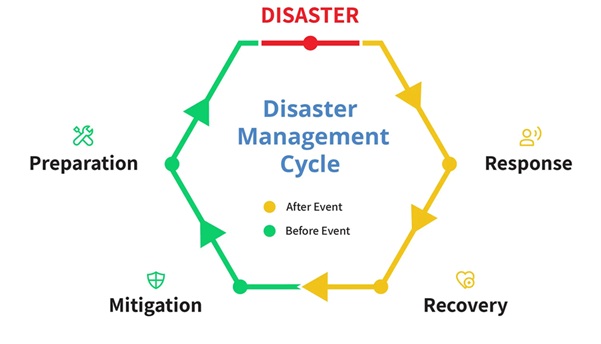| (Mains – GS Paper 3 :Disaster Management) |
India is a geographically and climatically diverse country, making it highly vulnerable to natural disasters such as earthquakes, floods, cyclones, droughts, landslides, heatwaves, cold waves, and forest fires. According to various reports, disasters cause nearly 2% loss to India’s GDP every year. This underscores the need for a robust, scientific, and community-centered disaster management system.

Major Disaster Risks in India
1. Earthquakes
- 59% of India’s land falls under moderate to very high seismic zones.
- Highly vulnerable regions include Himalayan belt, North Bihar, Kutch, and Andaman & Nicobar Islands.

2. Floods and River Erosion
- 40 million hectares (~12% of land area) are prone to floods and river erosion.
- The Ganga-Brahmaputra plains experience large-scale annual floods.
3. Cyclones and Coastal Hazards
- Out of 7,516 km of coastline, 5,700 km is prone to cyclones and tsunamis.
- Climate change is increasing the intensity of cyclones.
4. Droughts
- 68% of cultivable land is drought-prone.
- States like Maharashtra, Karnataka, Bundelkhand, and Rajasthan frequently face severe droughts.
India’s Disaster Management Approach and Vision
Approach
- Shift from a relief-centric model to a mitigation and preparedness-based model.
- Goal: Zero human casualties (Zero Casualty Approach).
National Disaster Management Plan (NDMP) 2019 Vision
- Make all regions of India disaster-resilient.
- Strengthen capacity at the local level.
- Minimize loss of life, livelihood, and property.
- Adopt the “Build Back Better” (BBB) principle.
Insurance Coverage Gap
Policy and Legal Framework
- National Disaster Management Act, 2005
- India’s primary disaster law.
- Establishes NDMA, SDMA, DDMA.
- Provides an institutional framework for disaster management.
- National Disaster Management Plan (NDMP) – 2019
- Prime Minister’s 10-Point DRR Agenda
- Integrate disaster risk reduction (DRR) into development planning.
- Strengthen scientific data and early warning systems.
- Enhance community-level capacities.
- Promote international cooperation.
Key Challenges in Disaster Management
- Low Investment in Risk Reduction (DRR)
- Most funds go into relief and rehabilitation, not prevention.
- Every $1 invested in DRR saves $15 in losses.
- Weak Early Warning Systems
- Cyclone warning systems are advanced, but warnings for cloudbursts, earthquakes, floods, and Himalayan disasters remain weak.
- Infrastructure and Urban Challenges
- Unplanned urbanization.
- Poor adherence to building codes.
- Unsafe constructions in coastal and hilly areas.
- Climate Change
- Glaciers melting faster.
- Groundwater levels declining.
- Increased frequency of heavy rainfall, heatwaves, and cyclones.
- Lack of Institutional Coordination
- Weak center-state-district-local coordination.
- Limited data-sharing mechanisms.
Institutional Structure and Initiatives
A. Key Institutions
- NDMA – Policy guidance.
- SDMA/DDMA – Implementation at state/district level.
- NDRF – Search and rescue operations.
- NIDM – Research and training.
- NCMC – High-level crisis management.
B. Financial Arrangements
- NDRF – Relief and rehabilitation.
- NDRMF – Risk reduction funding.
- State Disaster Response Fund (SDRF)
C. NDMA Guidelines
- Earthquake, flood, cyclone, cold wave, pandemic response.
D. Build Back Better (BBB)
- Post-disaster reconstruction to be safer and more resilient.
- Reduce future risks.
International Cooperation
- Sendai Framework (2015–2030) – Four pillars:
- Understanding disaster risk
- Disaster risk governance
- Disaster risk reduction
- Better post-disaster recovery
- India leads globally via Coalition for Disaster Resilient Infrastructure (CDRI).
Way Forward
- Increase Investment in DRR
- Allocate resources to risk reduction rather than just relief.
- Make DRR budget mandatory for states.
- Upgrade Early Warning Systems
- Immediate warnings for cloudbursts, mountain floods, and forest fires.
- Expand Doppler radars.
- Strengthen Local Governance
- Disaster Preparedness Committees in panchayats and urban bodies.
- School-level disaster education.
- Expand Insurance Coverage
- Promote micro-insurance, agriculture and urban disaster insurance.
- Develop risk-sharing models.
- Enforce Construction Standards
- Earthquake-resistant buildings.
- Adherence to Coastal Regulation Zone (CRZ) norms.
- Strict penalties for unsafe construction.
- Technology-Driven Disaster Governance
- GIS-based risk mapping.
- Drone-based monitoring.
- Upgrade mobile alert systems.
- Leverage Common Service Centres (CSCs)
- Disseminate warnings.
- Monitor relief distribution.
- Serve as local crisis information centers.
Conclusion
India’s disaster management framework has strengthened significantly in the past two decades with NDMA, NDRF, SDMA, NDMP, and PM’s 10-Point Agenda.However, challenges like climate change, urbanization, low insurance coverage, and underinvestment in DRR persist.By adopting the Sendai Framework and Build Back Better approach, India can evolve into a more resilient, prepared, and secure disaster management system, where disasters become not only a challenge but also an opportunity for better development.



